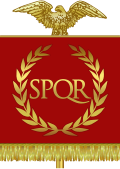Roman Empire
period of ancient Rome following the Republic From Wikipedia, the free encyclopedia
Remove ads
The Roman Empire ruled the Mediterranean and much of Europe, Western Asia and North Africa. The Romans conquered most of this during the Republic, and it was ruled by emperors following Octavian's assumption of effective sole rule in 27 BC. The western empire collapsed in 476 AD, but the eastern empire lasted until the fall of Constantinople in 1453.
The Empire started in 27 BC, when Octavian became Emperor Augustus after the death of Julius Caesar. The fall of Western Roman Empire to the Germanic kings in 476 AD, marked the end of classical antiquity and the beginning of the Middle Ages.[10]
The Empire was the third stage of Ancient Rome. Rome was first ruled by Roman kings, later by the Roman Republic and then by an emperor.
Many modern lands were once part of the Roman Empire such as, Britain (not Scotland), Spain, Portugal, France, Italy, Greece, Turkey, Germany, Egypt, Levant, Crimea, Switzerland and the northern coast of Africa. The main language of the Roman Empire was Latin, with Greek as an important secondary language, especially in the Eastern provinces.
The Western half of the Roman Empire lasted for about 500 years until the barbarian general Odoacer defeated its final emperor, Romulus Augustus. On the other hand, the eastern half, consisting of the Balkans, Anatolia, The Levant and Egypt, continued for about 1000 more years before falling to the Ottomans. The Levant and Egypt were lost to the Arabs in the 8th century. The eastern part was the Eastern Roman Empire, more commonly known as the Byzantine Empire. Its capital was Constantinople, which is now called Istanbul.
Remove ads
Government
In order to control their large empire, the Romans developed ideas about law and government. They developed the best army in the world at the time and ruled by force. They had fine engineering and built roads, cities, and outstanding buildings. The Empire was divided into provinces, each with a governor plus civil and military support. Letters, both official and private, went constantly to and from Rome.
Trade was most important for Rome, a city of more than a million people (which was by far the largest city in the world). It needed and got wheat from Egypt, tin from Britannia, grapes from Gaul and so on. In return, the Romans built provincial capitals into fine cities, protected them from raids by barbarians. They gave education and career opportunities for young people in the provinces, such as jobs in the Roman army.
In principle, Emperors had absolute control and could do as they pleased. In practice, they faced some difficult problems. They had a staff of what would today be called "civil servants" and the advice of the Roman Senate. The emperor had to decide the most important issues facing the empire, and what should be done about them. Most tried to do two things. One was doing things to improve the life of Romans in peacetime. The other was fighting and defeating Rome's enemies, which the wealthy empire always had.
For Roman emperors the succession would often be an adopted son. The Emperor would notice an outstanding young man from one of the best families and would adopt him as his son. Before he died, he would make clear who he thought should succeed him. He could make his adopted son a Roman consul, or state in his will that the younger man should succeed him. Sometimes, that worked well. but not always. Every now and then, a civil war would be fought between claimants to the throne.
An adopted son or two gave the Emperor more choices. Some Emperors had no son, and others had sons who did not survive. Later on, Emperors grew so weak that the Roman army would just pick one of their generals to be the next Emperor, which sometimes led to civil war.
The Romans fought many wars against other countries and against barbarians several times. They enjoyed watching violent sports. They watched chariots races and fights between gladiators (men using weapons). Unlike in modern sports, the fighters were often killed in fights. Romans enjoyed those shows in the Colosseum.
The Romans had great civil engineering. They built many large public buildings and villas, aqueducts to carry water, stone bridges and roads. Some of those things can still be seen today. Many famous writers were Romans, including Cicero and Virgil.
The New Testament of the Bible tells about the Romans in the life of Jesus Christ. During Jesus' life, the Romans, who were pagans, ruled his country. Later, several emperors tried to destroy Christianity but did not succeed. By 312 AD, Emperor Galerius allowed people freedom to follow Christianity, and the next year, a general, Constantine, became Emperor and converted to Christianity.
The city of Rome was taken over several times by barbarians, notably in 410 AD when a barbarian tribe called the Goths sacked the city (looting). The last Western Roman emperor, Romulus Augustus, abdicated in 476 AD. The Roman Empire would last another 1000 years as the Byzantine Empire in the East.
The main coin of the Roman Empire was the silver denarius. Later denarii were smaller.
Various reasons have been given for the fall of Rome. Edward Gibbon wrote The Decline and Fall of the Roman Empire in which he investigated various ideas. Chief among them was, in his opinion, the effect of Christianity on the ability of the Empire to defend itself militarily.
Other historians blame the unstable system of leadership. In a later 50-year period, only two of 22 emperors died a natural death. Most of the other emperors were assassinated.[11]
Remove ads
References
Other websites
Wikiwand - on
Seamless Wikipedia browsing. On steroids.
Remove ads



